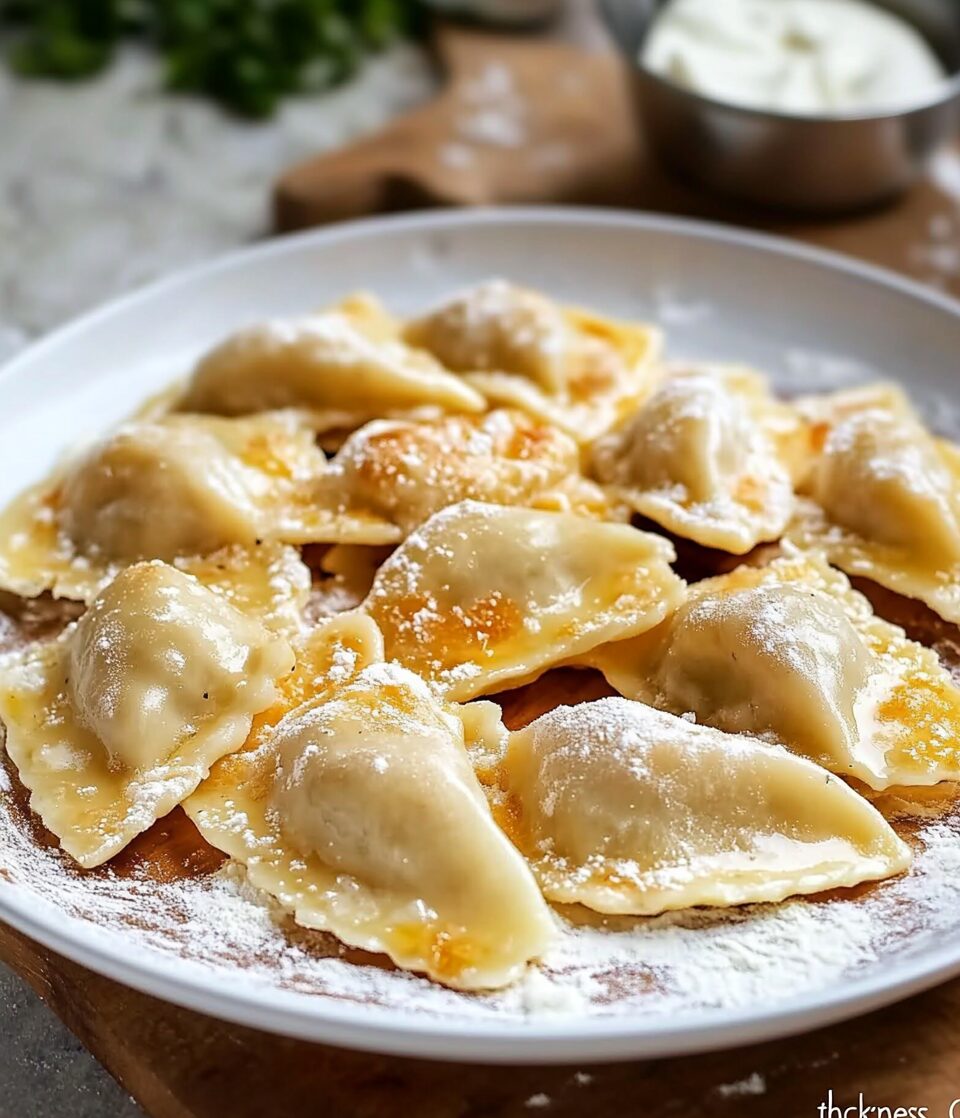The humble yet deeply satisfying Pierogi Ruskie is a staple of Polish cuisine, loved for its creamy mashed potato and cheddar filling encased in soft, hand-kneaded dough. Sautéed with golden onions and drizzled in a buttery sauce, this dish delivers comfort in every bite.
Perfect as a weekend cooking project or to serve at your next family dinner, these dumplings are rich, flavorful, and freezer-friendly. With simple ingredients and step-by-step instructions, you’ll enjoy the process almost as much as the end result. Serve with sour cream and herbs for that authentic Polish touch.
Full Recipe:
For the Dough:
-
2 cups plain/all-purpose flour
-
1 tsp kosher salt
-
50g / 3 tbsp unsalted butter
-
1/2 cup warm water
-
1 large egg, whisked
For the Filling:
-
500g / 1 lb potatoes, peeled and sliced
-
1 tbsp kosher salt (for boiling potatoes)
-
30g / 2 tbsp unsalted butter
-
1 cup shredded cheddar cheese (tightly packed)
-
1/4 tsp kosher salt
-
1/2 tsp black pepper
For the Onion Butter Sauce:
-
30g / 2 tbsp unsalted butter
-
1 onion, finely diced
-
1/2 tsp kosher salt
For Serving:
-
25g / 1 1/2 tbsp unsalted butter (per 8–10 pierogi)
-
Sour cream
-
Fresh parsley or chives, finely chopped
Directions:
-
Make the Filling:
Boil potatoes with 1 tbsp salt in cold water. Once soft (about 15 minutes), drain and mash. Immediately mix in butter, cheese, salt, and pepper. Spread on a tray, cover with cling wrap, and cool at room temperature for 30 minutes. Refrigerate until firm, at least 1 hour. -
Prepare the Dough:
Melt butter into warm water. In a bowl, whisk flour and salt, then make a well in the center and pour in melted butter mixture and egg. Mix into a rough dough, knead for 5 minutes until smooth. Wrap and rest for 30 minutes. -
Shape the Pierogi:
Roll dough to 1/8″ thickness. Cut into 3” rounds. Place 1 tbsp of filling in the center of each round. Wet half the edge with water, fold over, and pinch to seal. Repeat with remaining dough and filling. -
Cook the Onion Butter:
Sauté onion with butter and salt until golden, about 10–15 minutes. Set aside. -
Boil and Serve:
Boil pierogi in salted water (10 at a time) for 5 minutes, until they float. Drain and reserve 1 cup of cooking water. In a skillet, melt butter, add onion, pierogi, and a splash of cooking water. Toss to coat. Serve with sour cream and herbs.
Prep Time: 1 hour (including cooling) | Cooking Time: 30 minutes | Total Time: 1 hour 30 minutes
Kcal: 290 kcal (per serving) | Servings: Makes 30 pierogis (serves 6–8)
A Deep Dive into Pierogi Ruskie: The Heart of Polish Comfort Food
When it comes to comfort food that speaks to the soul, few dishes do it quite like Pierogi Ruskie. These dumplings, filled with a rich mixture of creamy mashed potatoes and cheese, have traveled from humble Polish kitchens to dining tables around the world. Revered for their satisfying taste, simplicity, and versatility, Pierogi Ruskie represent more than a meal — they are a cultural symbol, a family tradition, and an enduring comfort.
The History and Origins of Pierogi Ruskie
Pierogi, as a dish, date back centuries and are a staple across Eastern Europe. They are considered national treasures in countries like Poland, Ukraine, and Slovakia. “Pierogi Ruskie” literally translates to “Ruthenian Pierogi,” referring to the historical region of Ruthenia, which once encompassed parts of today’s Poland and Ukraine. Despite the name, this variety is purely Polish in identity and is widely embraced throughout the nation as a beloved classic.
Originally a peasant dish, pierogi became popular across all social classes due to their affordability and filling nature. The potato and cheese combination likely developed after potatoes were introduced to Europe, and it remains one of the most cherished variations.
What Makes Pierogi Ruskie So Special?
The appeal of Pierogi Ruskie lies in its elemental perfection. The filling is a decadent blend of mashed potatoes and cheese, traditionally a tangy white cheese like quark or twaróg, though modern recipes often use cheddar for accessibility. The dough is soft yet slightly chewy, providing the perfect envelope for the rich interior. But what elevates this dish to pure indulgence is the onion butter sauce that’s often used as a topping — it coats the dumplings in a golden, savory glaze that adds aroma, depth, and moisture.
They’re often served with sour cream and a sprinkle of herbs like parsley or chives, adding a tangy and fresh contrast to the buttery, starchy base. It’s a meal that engages every sense: comforting aromas, a warm, yielding texture, and an umami-rich flavor profile.
Pierogi as a Cultural Tradition
In Poland, pierogi are far more than food — they are part of the cultural DNA. They are featured during major holidays like Christmas Eve (Wigilia), weddings, family gatherings, and church festivals. The process of making them, especially from scratch, is traditionally a communal activity. Multiple generations of family members often gather around the kitchen table to roll, fill, and seal the dumplings, turning cooking into a shared memory.
Even outside Poland, pierogi maintain strong emotional and cultural ties for Polish communities abroad. For many, preparing Pierogi Ruskie is an act of heritage preservation, a culinary connection to their ancestry and homeland.
Modern Variations and Adaptations
Though Pierogi Ruskie has a fairly straightforward composition, it’s a recipe that invites customization. Some cooks add caramelized onions directly into the filling, while others mix in herbs or even bits of bacon for a smokier flavor. The cheese component can also vary widely — from mild ricotta to sharp aged cheddar or even blue cheese for an adventurous twist.
In terms of cooking technique, boiled pierogi are the norm, but pan-frying them afterward in butter for a crispy exterior has become immensely popular. Some even bake them or deep-fry them for textural variety. It’s common to see them served not only with onion butter sauce, but also mushroom gravies, tomato-based sauces, or even lightly sweetened toppings when made with dessert-style fillings.
Nutrition and Serving Suggestions
Despite their indulgent flavor, Pierogi Ruskie can be part of a balanced meal when paired with a side of vegetables or a fresh salad. A portion of 4–5 dumplings provides a satisfying serving size for most adults. They are vegetarian-friendly and provide a good dose of carbs, fats, and protein. For a lighter take, some modern cooks opt for whole wheat flour or sweet potatoes to add nutritional value and color.
They make a fantastic entrée on their own or can serve as a side dish to a more protein-centric main course. Because they’re freezer-friendly, many people like to prepare them in large batches and cook them from frozen, making them an excellent option for meal prepping.
Tips for Perfect Pierogi
There are a few essential tips for making Pierogi Ruskie successfully:
-
Chill the filling completely before assembly. This makes it easier to handle and prevents the dough from becoming soggy.
-
Don’t overstuff the dumplings. While it may be tempting to add extra filling, it can cause them to burst during cooking.
-
Use well-kneaded, rested dough. This ensures flexibility and elasticity, making the wrapping process smoother.
-
Cook in salted water to enhance the flavor of the dough.
-
Don’t overcrowd the pot. Give pierogi room to float and move freely while boiling for even cooking.
Freezing and Reheating
One of the beauties of Pierogi Ruskie is how well they freeze. Once assembled and sealed, you can freeze them on a tray in a single layer, then store them in an airtight container or zip-top bag. They don’t require thawing before cooking — just add a few extra minutes to the boiling time.
For reheating leftovers, lightly pan-frying in butter is ideal. It restores the warmth and adds a delicious crispy layer that enhances the soft interior.
Global Popularity and Modern Resurgence
As comfort food continues to trend globally, pierogi are having a moment. Restaurants across North America, the UK, and Australia now feature these Polish dumplings on their menus. With the growing popularity of global cuisines and the appreciation for traditional, handmade foods, Pierogi Ruskie have found new audiences beyond their cultural origins.
Food bloggers and home cooks alike are reintroducing pierogi to the digital generation, often sharing video tutorials, step-by-step guides, and stories of cooking with their grandparents. Social media platforms like Instagram and TikTok are filled with visuals of golden-fried dumplings, garnished artfully with herbs, sour cream, and crispy onions.
Pairings and Serving Ideas
Pierogi Ruskie pair beautifully with a variety of accompaniments. For a traditional experience, serve them with:
-
Sour cream: The cooling tang cuts through the richness.
-
Chopped fresh herbs: Parsley, dill, or chives add freshness and color.
-
Sautéed vegetables: Especially red cabbage or carrots, which provide texture and acidity.
-
Light salad: Greens dressed in a sharp vinaigrette offer balance.
For a modern twist, try them alongside roasted meats, grilled mushrooms, or even drizzled with a truffle oil and crispy pancetta for a gourmet touch.
Conclusion: Why Pierogi Ruskie Are Worth the Effort
Pierogi Ruskie may take time to make from scratch, but every minute spent is rewarded with a plate of soul-warming satisfaction. Their versatility, cultural significance, and sheer deliciousness make them a staple worth learning and sharing. Whether you’re honoring your heritage or simply exploring new culinary frontiers, Pierogi Ruskie offer a flavorful, heartfelt journey into Polish cuisine.
They are a beautiful reminder that sometimes, the simplest ingredients — potatoes, cheese, butter, and flour — when combined with tradition and love, can become something extraordinary. Whether enjoyed with family on a festive night or savored solo with a glass of wine, these dumplings never fail to deliver joy.






